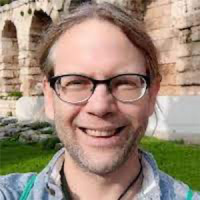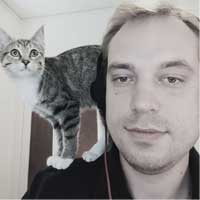Why Study Bioinformatics? A Conversation with Professor and YouTuber Danny Arends, PhD
Search For Schools
When you click on a sponsoring school or program advertised on our site, or fill out a form to request information from a sponsoring school, we may earn a commission. View our advertising disclosure for more details.
“And that is why bioinformatics is so interesting because biology has real questions—questions that matter. Like, why do people get cancer? Why do we grow old? How do we get more from the field we are currently working on?”
Danny Arends, PhD, Associate Professor of Bioinformatics, University of Northumbria, England
Bioinformatics is a dynamic and quickly growing field that sits squarely at the intersection of science and technology. Bioinformaticians use algorithms, computer modeling, and, increasingly, artificial intelligence to answer big questions and create visualizations from the ever-growing data sets generated in biological research laboratories.
One of the signature accomplishments of bioinformatics is undoubtedly the Human Genome Project. This 13-year effort culminated in the sequencing of the entire human genome, and was declared complete in 2003, at which point roughly 93 percent of the genome had been sequenced. In 2022, the remaining percentages were successfully sequenced, resulting in a staggering achievement with implications for geneticists, medical scientists, and biologists worldwide.
Meet the Expert: Danny Arends, PhD

Dr. Danny Arends is an associate professor of bioinformatics at the University of Northumbria, England. In addition to a master’s degree in molecular biology, he holds a PhD in bioinformatics and has completed a postdoctoral program in computational biology at Humboldt University in Berlin.
As a former biologist, some of his research focuses on plant life and the challenges posed by a warming planet for vital food crops. In addition to working on several projects related to the human genome, he is regularly drawn to work on bees, whose genetic makeup he describes as utterly fascinating.
Making Bioinformatics Accessible
While some bioinformaticians spend their entire careers working on highly specific programs or applications in limited fields, others spend much of their time in communication between the fields they combine: biology and computer science.
One such individual is Dr. Danny Arends, an associate professor at the University of Northumbria in Newcastle upon Tyne in the north of England: “The reason that I was really interested in bioinformatics is because when I started university, I initially chose to do computer science, and I hated that—I absolutely hated that!—because there are no fun questions,” said Dr. Arends in a recent interview.
“The questions that computer scientists deal with are how do I compute this thing that we can already compute, but do it more efficiently,” Dr. Arends said. “And that is why bioinformatics is so interesting because biology has real questions—questions that matter. Like, why do people get cancer? Why do we grow old? How do we get more from the field are currently working on?”
To Dr. Arends’ mind, bioinformatics offers a pathway to answering questions that feel much bigger than those of speed, efficiency, and efficacy that made up the core of much of his training in computer science: “These are things which bioinformatics can really help with—they are the big questions that our society faces currently, with a growing population, an aging population, and a reduction in usable land with climate change taking away more and more land, making it arid with higher salinities.”
Choosing to follow the big questions, Dr. Arends switched his focus to molecular biology, where he had the opportunity to pursue them: “I have a master’s in molecular biology, and then decided to use my programming skills instead of just being in a lab doing pipetting work,” he said, explaining how he moved from an initial interest in programming to biology to now being firmly anchored in a field which combines both of these passions.
What sets Dr. Arends apart from some of his more introverted peers is that he is highly active on social media, uploading his university lectures to YouTube, along with a slew of explainer videos aimed at a general audience interested in his field: “I’ve always been interested in doing education, so even during my high school years, I was already teaching and helping people with physics and mathematics and these kinds of things, and then when I started teaching at university, I found that teaching other people is just a great way of scaling myself,” he explains. “I can only write one program a day, more or less, but if I teach ten people how to program, they can write ten programs a day.”
During the Covid-19 epidemic, Dr. Arends found an opportunity to make his lectures available to the general public: “That’s something I really fought for at my last university,” he says. “I was able to convince them when I said that what the university is selling aren’t the lectures themselves, but the credits and diplomas, so that’s what ended up convincing them to let me do it.”
Challenges Faced in the Bioinformatics Field
As enthusiastic as Dr. Arends is about his field, he is also direct in addressing the challenges in bioinformatics: “Nowadays, we sequence everything. So you go to the doctor or you go to the hospital, and the first thing that they do is they draw blood, and they sequence your genome.”
These datasets provide a level of specificity in treatment courses that would have been hard to imagine even a generation ago. “We are moving towards this age of personalized medicine where the medicine you get is based on your genetic profile, so we give you medicine that we know works for your genetic makeup,” Dr. Arends says.
However, the larger these datasets become, the more issues researchers and medical professionals face in managing them. Dr. Arends cites Moore’s Law—an axiom that holds that computing power doubles roughly every 18 months: “It hasn’t been doing that the last couple of years because we are moving more towards a multi-core world instead of more power in a single core,” Dr. Arends explains.
That said, even if computing power were to keep pace with the massive amounts of information generated by biologists, geneticists, and other researchers, it still wouldn’t be enough to keep pace: “And that is without new challenges like large language models and these kinds of things coming in and taking away computational power from the kind of bioinformatics that I focus on,” Dr. Arends says.
Essentially, bioinformaticians compete with other large data users, as they rely on the same cloud infrastructure. “We have a 1,000 Genome Project in Holland, we have a global 1,000 Genome Project, and all of these things are siloed together. We are not individual research groups working on individual diseases anymore; it’s more like a global community that uses big infrastructure like Google, Amazon, and all of these big cloud infrastructure providers to solve the great questions.”
In Dr. Arends’ telling, bioinformaticians not only compete with each other for a finite amount of storage space, but with other major users of bandwidth. This includes cryptocurrency, a notorious consumer of bandwidth and computing power.
The Promise of Bioinformatics: Translating Between Disparate Fields
As for the promises of bioinformatics, they could not have a more enthusiastic cheerleader than Dr. Arends. In his telling, he finds one of the most vital functions of his field in the “bridge” role that he and other bioinformaticians fill, sitting squarely in the gap between biological and computer sciences and speaking to both sides.
“I always see myself as a kind of translator, so I translate the requirements of the biologists into something that computer scientists can understand, and I translate the language that computer scientists speak back to the biologists in a way that they can understand.”
As a person with experience in both fields, Dr. Arends is uniquely equipped to speak the languages of both parties: “I’m seeing myself more as a facilitator for making other people’s research possible, relative to me being a hardcore bioinformatician who works on his own software and just strives to optimize that,” he says. Translating research into code and the reverse is a calling that Dr. Arends has a clear and palpable passion for. At which end of the equation he finds himself is less important to him than the results: “Other people do bioinformatics for the fun of running pipelines and using these big computer systems, but for me, computers are just the tool to solve these big issues that we are faced with in society.”
Dr. Arend’s YouTube Channel may be an ideal starting point for those interested in pursuing a career in bioinformatics. From the basic components of his work, like data management, sequencing, and visualization to upper-level genetics and programming in R, his channel offers a wealth of information to those beginning their first forays into the field and those already engaged in studies or work related to bioinformatics.

